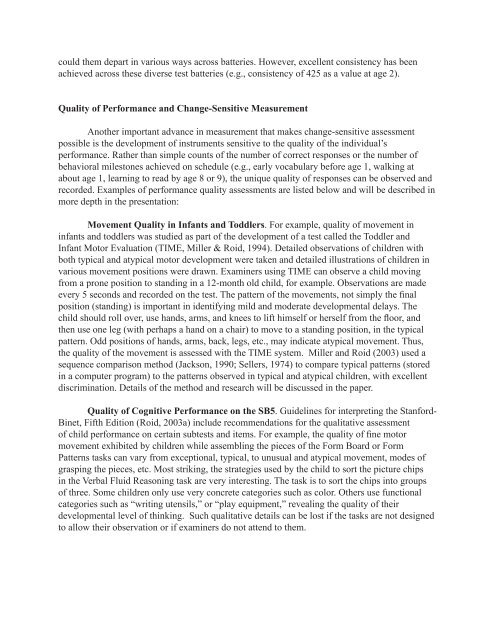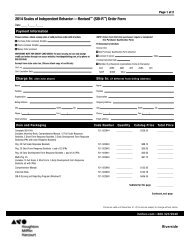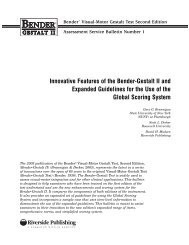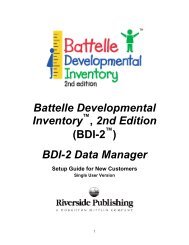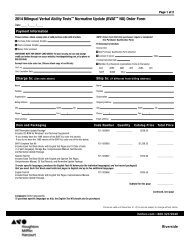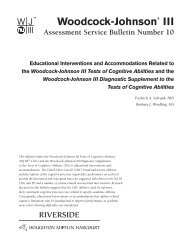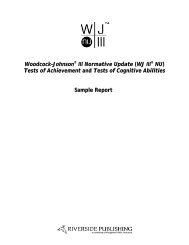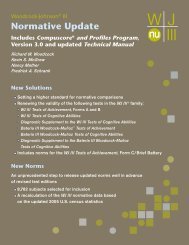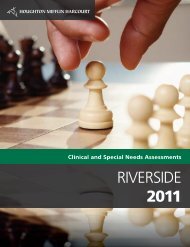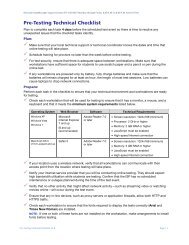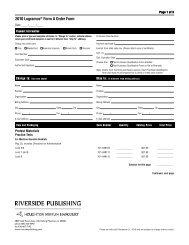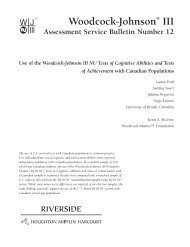Quality of Performance and Change-Sensitive ... - Nelson Education
Quality of Performance and Change-Sensitive ... - Nelson Education
Quality of Performance and Change-Sensitive ... - Nelson Education
Create successful ePaper yourself
Turn your PDF publications into a flip-book with our unique Google optimized e-Paper software.
could them depart in various ways across batteries. However, excellent consistency has beenachieved across these diverse test batteries (e.g., consistency <strong>of</strong> 425 as a value at age 2).<strong>Quality</strong> <strong>of</strong> <strong>Performance</strong> <strong>and</strong> <strong>Change</strong>-<strong>Sensitive</strong> MeasurementAnother important advance in measurement that makes change-sensitive assessmentpossible is the development <strong>of</strong> instruments sensitive to the quality <strong>of</strong> the individual’sperformance. Rather than simple counts <strong>of</strong> the number <strong>of</strong> correct responses or the number <strong>of</strong>behavioral milestones achieved on schedule (e.g., early vocabulary before age 1, walking atabout age 1, learning to read by age 8 or 9), the unique quality <strong>of</strong> responses can be observed <strong>and</strong>recorded. Examples <strong>of</strong> performance quality assessments are listed below <strong>and</strong> will be described inmore depth in the presentation:Movement <strong>Quality</strong> in Infants <strong>and</strong> Toddlers. For example, quality <strong>of</strong> movement ininfants <strong>and</strong> toddlers was studied as part <strong>of</strong> the development <strong>of</strong> a test called the Toddler <strong>and</strong>Infant Motor Evaluation (TIME, Miller & Roid, 1994). Detailed observations <strong>of</strong> children withboth typical <strong>and</strong> atypical motor development were taken <strong>and</strong> detailed illustrations <strong>of</strong> children invarious movement positions were drawn. Examiners using TIME can observe a child movingfrom a prone position to st<strong>and</strong>ing in a 12-month old child, for example. Observations are madeevery 5 seconds <strong>and</strong> recorded on the test. The pattern <strong>of</strong> the movements, not simply the finalposition (st<strong>and</strong>ing) is important in identifying mild <strong>and</strong> moderate developmental delays. Thechild should roll over, use h<strong>and</strong>s, arms, <strong>and</strong> knees to lift himself or herself from the floor, <strong>and</strong>then use one leg (with perhaps a h<strong>and</strong> on a chair) to move to a st<strong>and</strong>ing position, in the typicalpattern. Odd positions <strong>of</strong> h<strong>and</strong>s, arms, back, legs, etc., may indicate atypical movement. Thus,the quality <strong>of</strong> the movement is assessed with the TIME system. Miller <strong>and</strong> Roid (2003) used asequence comparison method (Jackson, 1990; Sellers, 1974) to compare typical patterns (storedin a computer program) to the patterns observed in typical <strong>and</strong> atypical children, with excellentdiscrimination. Details <strong>of</strong> the method <strong>and</strong> research will be discussed in the paper.<strong>Quality</strong> <strong>of</strong> Cognitive <strong>Performance</strong> on the SB5. Guidelines for interpreting the Stanford-Binet, Fifth Edition (Roid, 2003a) include recommendations for the qualitative assessment<strong>of</strong> child performance on certain subtests <strong>and</strong> items. For example, the quality <strong>of</strong> fine motormovement exhibited by children while assembling the pieces <strong>of</strong> the Form Board or FormPatterns tasks can vary from exceptional, typical, to unusual <strong>and</strong> atypical movement, modes <strong>of</strong>grasping the pieces, etc. Most striking, the strategies used by the child to sort the picture chipsin the Verbal Fluid Reasoning task are very interesting. The task is to sort the chips into groups<strong>of</strong> three. Some children only use very concrete categories such as color. Others use functionalcategories such as “writing utensils,” or “play equipment,” revealing the quality <strong>of</strong> theirdevelopmental level <strong>of</strong> thinking. Such qualitative details can be lost if the tasks are not designedto allow their observation or if examiners do not attend to them.


